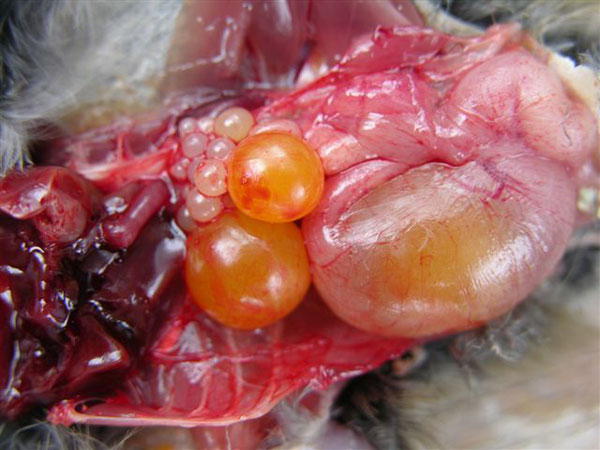
This female House Sparrow (Passer domesticus or HOSP ) was caught on March 23, 2008, and dissected. (HOSP are not protected under the federal Migratory Bird Treaty Act, as they are a non-native, invasive species.) This female had already laid four eggs in a nestbox. You can see the fifth egg in the oviduct, forming a lining over the egg yolkd and egg white. A sixth and seventh egg are forming with a yolk in the center of the photo. To the left are another 15 or so smaller “seed” eggs. The female HOSP can cut off this string when she completes a full clutch (HOSP generally lay 1-8 eggs per clutch.)
This photograph is gory, but does do an excellent job of illustrating the “conveyor belt” egg production process. Photo and information from Keith Kridler.
Stages of egg production:
- Eggs in the ovary: The ovary holds undeveloped eggs (several hundred to a thousand or more). Yolk deposition begins in the ovary, which contains several eggs in various stages of development. In bluebirds, the yolk takes four days to develop, plus one more day to finish the egg, for a total of five days (per Dr. David Pitts.)
- Ovulation: the egg is released by the ovary into the oviduct. This usually happens every 24 hours.
- Fertilization: In the infundibulum (the first section of the oviduct) the egg is fertilized by male sperm. This has to happen before the egg white is added, because sperm can’t get past the egg white. In Downy Woodpeckers, the egg is only in the infundibulum for about 20-30 minutes.
- Albumen Added: the egg moves down the oviduct and into the magnum where the albumen is deposited.
- In the isthmus, two membranes are added: the inner membrane (that surrounds the albumen), and the outer membrane
- Shell Formed: In the uterus, the shell is formed (over a period of about 20 hours in a Downy.)
- Egg is laid: Usually one a day (sometimes skipping a day) until the clutch is complete.
More information:
- Egg hatching
- Supplementing Calcium – Feeding Chicken Eggshells, etc. to Birds
- How Many Eggs Will a Female Lay?
- unhatched eggs.htm”>Why didn’t the eggs hatch?
- House Sparrow Biology
- House Sparrow Control (passive and active methods)
- Weird eggs (various species)
- Egg sizes (comparison table) for various small cavity nesters
- Nest and Egg Identification (photos and descriptions)
- House Sparrow egg photos
- House Sparrow History
- House Sparrow Proliferation
- House Sparrow Photos
- Interesting facts about eggs
The FIRST bluebird eggs I saw were when my father lifted me up and held me in his arms so that I could see down into the nest. Five delicate, sky blue eggs nestled in a beautifully woven grass nest! That chance nesting of the bluebirds in our nestbox helped to encourage a lifetime of memories!
– Keith Kridler, Bluebird_L, 2008
